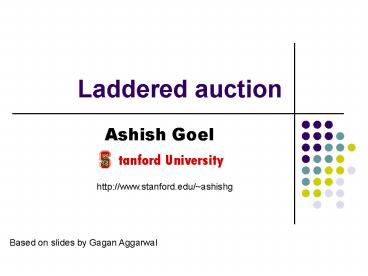Laddered auction - PowerPoint PPT Presentation
Title:
Laddered auction
Description:
... [Hal Varian] and [Edelman, Ostrovsky and Schwarz] show that the VCG outcome is a bidder-optimal envy-free equilibrium of the next-price auction. – PowerPoint PPT presentation
Number of Views:56
Avg rating:3.0/5.0
Title: Laddered auction
1
Laddered auction
- Ashish Goel
tanford University
http//www.stanford.edu/ashishg
Based on slides by Gagan Aggarwal
2
(No Transcript)
3
Setting
- Different slots provide different amounts of
visibility. - Problem
- How to match advertisers to slots.
- What price to charge.
- Large, dynamic markets.
- Current solution run an auction.
4
Next-price auctionA.k.a. Generalized
Second-Price auction
- Advertisers submit bids.
- Place advertisers in decreasing order of weighted
bid. - Yahoo uses (used?) uniform weights.
- Google weights each advertiser by her quality
score. - Each advertiser is charged the bid of next-lower
advertiser (scaled appropriately in the weighted
case).
5
Example
30
2nd slot
20
3rd slot
Top slot
Bid/click
14
2nd slot
10
3rd slot
4th slot
0
15
20
30
50
Clicks/100 impressions
6
What does an advertiser want?
- An advertiser pays only when her ad gets clicked.
- Valuation True worth of a click.
- E.g. the expected value of a sale generated by
the click. - Profit valuation price.
- CTR fraction of times an ad gets clicked
- clicks / impressions.
7
Auction is not truthful
- An auction is truthful if the best strategy for a
bidder is to bid her true valuation. - Current ad auctions are not truthful
- Top slots are priced higher than bottom slots.
- Increase in CTR may not always compensate for the
higher price - Assumptions
- Infinite budget per advertiser.
- Rational advertisers who are trying to maximize
profit, defined as - Profit valuation - price
8
Example
30
2nd slot
20
3rd slot
14
Bid/Valuation per click
10
0
15
20
30
50
Clicks/100 impressions
9
(No Transcript)
10
Why a new auction?
- A good bid depends on others bids.
- Competing bids keep changing due to bid changes
by others and due to budget smoothing. - Not-so-savvy advertisers are unable to keep up
and often bid suboptimally. - Some use third parties to do their bidding.
- Goal Simplify the task of bidding by making the
auction truthful (the best strategy for a bidder
is to bid its true valuation). - Use VCG?
- Good when CTRs are separable
- Does not apply when CTRs are not separable
- VCG give every advertiser a discount equal to
the extra revenue it generates
11
Laddered auction
- Rank advertisers according to rule bi qi.
- Consider the advertiser ranked j,
- For the clicks it would have received at slot
j1, charge the same per-click amount as would
have been charged at the (j1)st slot. - For any additional clicks, charge the minimum bid
required to get the j-th slot. - Recursive definition
Aggarwal, Goel, Motwani EC06
12
Example
Top slot
30
Discount
20
3rd slot
Top slot
15
Bid/Valuation per click
4th slot
2nd slot
10
3rd slot
No ad
4th slot
0
15
20
30
50
Clicks/100 impressions
13
Properties of the Laddered auction
- Theorem
For any given ranking vector, the Laddered
Auction is the unique truthful auction.
14
TruthfulnessCannot gain by moving higher or lower
30
2nd slot
20
3rd slot
Top slot
15
Bid/Valuation per click
4th slot
2nd slot
10
3rd slot
4th slot
0
15
20
30
50
Clicks/100 impressions
15
Comparison with the current auction
- Nash Equilibrium A set of bids s.t. no single
bidder can gain by deviating. - Current auctions have several equilibria with
different revenues. - Theorem
- For separable CTRs, there exists a set of bids
under the current auction s.t. - They produce the same outcome (in allocation,
pricing and thus revenue) as the laddered
auction. - The bids form a Nash equilibrium.
16
Related work
- When click-through rates are separable, our
pricing method reduces to VCG with appropriate
weights. - For the case of separable CTRs,
- Hal Varian and Edelman, Ostrovsky and Schwarz
show that the VCG outcome is a bidder-optimal
envy-free equilibrium of the next-price auction. - Lahaie Truthful pricing schemes for the special
case of Google and Yahoos ranking scheme.
17
Summary and open problems
- Current ad auctions are not truthful.
- Laddered auction is the unique truthful auction
in general for fixed quality vectors. - There is an equilibrium of the current auction
that achieves the same outcome as the laddered
auction, assuming separability. - Open problems
- Can we put the repeated nature of the auction to
better use? - More general revenue equivalence
- Better pricing models which take into account
- budgets
- information
- slots































